#Changyuraptor yangi
Explore tagged Tumblr posts
Text

#sketch#life series#no series in particular#trafficblr#my art#design notes: the wings are based on changyuraptor yangi#honestly this started as scar but i figured i should do a few more
3 notes
·
View notes
Text
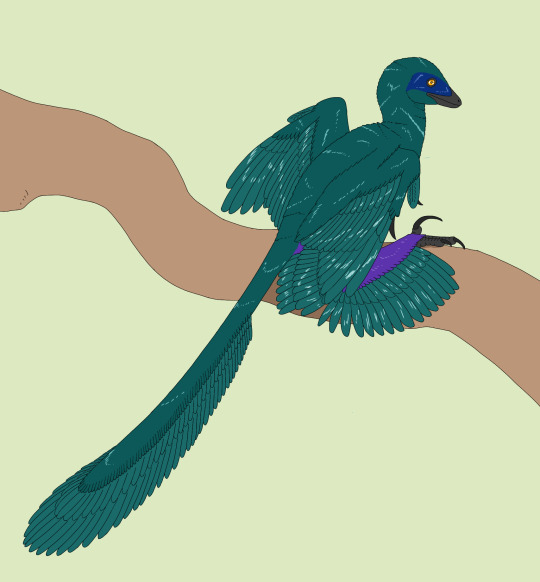
Changyuraptor yangi
8 notes
·
View notes
Text

Another Microraptorian from Cretaceous China, Changyuraptor yangi was the largest four-winged dinosaur known and possibly the largest non-avialan dinosaur capable of flight. It was around 1.2 metres (3.9 ft) long, most of which is attributed to its long tail feathers, and was about as tall as a turkey.
79 notes
·
View notes
Text
Changyuraptor yangi

By Scott Reid
Etymology: Long Feathered Robber
First Described By: Han et al., 2014
Classification: Dinosauromorpha, Dinosauriformes, Dracohors, Dinosauria, Saurischia, Eusaurischia, Theropoda, Neotheropoda, Averostra, Tetanurae, Orionides, Avetheropoda, Coelurosauria, Tyrannoraptora, Maniraptoromorpha, Maniraptoriformes, Maniraptora, Pennaraptora, Paraves, Eumaniraptora, Dromaeosauridae, Microraptoria
Status: Extinct
Time and Place: About 124.4 million years ago, in the Aptian of the Early Cretaceous


Changyuraptor is known from the Dawangzhangzi Bed of the Yixian Formation

Physical Description: Changyuraptor was a medium sized dinosaur, about 1.2 meters long - something like a modern turkey in terms of weight. It was covered from head to toe in feathers, including full wings on its arms, a large tail fan, and wings on its legs. It had a small, pointy head and long tail, while its body was fairly stocky. It also had sharp claws on its hands and sickle claws on its feet, like other raptor-dinosaurs. It’s tail was so long and feathered - with feathers reaching up to 30 centimeters in length and being the largest feathers known in a non-avian dinosaur - it would have allowed for softer landings for Changyuraptor. In short, it was probably the largest and fluffiest four-winged dinosaur known.
Diet: Changyuraptor would have primarily fed upon small animals like mammals, lizards, and amphibians.
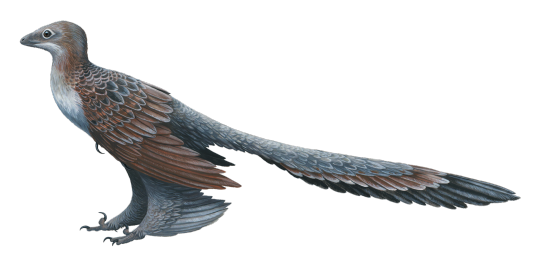
By Emily Willoughby, CC BY-SA 4.0
Behavior: Like Microraptor, Changyuraptor was probably capable of flight, making it one of the largest flying dinosaurs of the Mesozoic Era - with very few birds ever growing larger than it. It wouldn’t have been a particularly good flier though, only about as well as a chicken, taking off clumsily from the ground to go from area to area. It didn’t have enough strength in the chest and wing muscles to do much more than this, though it’s possible the hindlimb feathers would have allowed for some maneuvering in the air. It then could pounce on its prey, using its sickle claw to hold onto struggling animals before eating them.
More importantly; the wings, tail fan, and leg wings would have all been good display structures for Changyuraptor, which would have used them to communicate with other members of the species. These feathers would have signaled anger, a desire to mate, or danger, as feathers today are used by birds. It’s probable, then, that at least some fancy coloration may have been present on Changyuraptor to aid in the communication. Changyuraptor would have been a very active animal and most likely would have taken care of its young. In fact, it may have used its variety of wings and fans to help brood the nest.
Ecosystem: Changyuraptor lived in the Yixian Formation, a highly diverse ecosystem showcasing the evolution of birdie dinosaurs - like Changyuraptor - at the beginning of the Cretaceous period. A temperate, seasonal, and humid climate, it was much like the modern day northwestern Pacific Coast, though it would have seen snow on a regular basis, as well as notable dry seasons. It was a diverse coniferous forest, with a variety of flowering plants, ferns, horsetails, ginkgoes, cycads, seed ferns, and many others. Changyuraptor would have probably spent most of its time in the trees as well as on the ground, given its flight ability. There were a lot of freshwater lakes, and abundant volcanic eruptions.
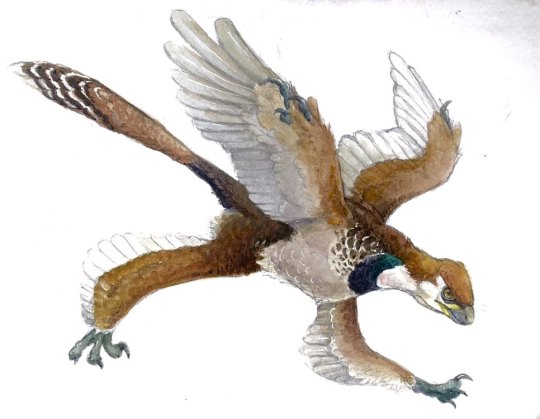
By Ripley Cook
Changyuraptor lived along so many other kinds of dinosaurs, it’s almost impossible to list them all. There were ankylosaurs like Liaoningosaurus and ornithopods like Bolong and Jinzhousaurus. There was the larger Compsognathid Sinosauropteryx, as well as many raptors in addition to Changyuraptor like the large Zhenyuanlong, Sinornithosaurus, and Tianyuraptor. There was also the Troodontid Jianianhualong, the seed eating protobird Jeholornis, smaller protobirds like Confuciusornis and Zhongornis, and the Anchiornithid Yixianosaurus. Opposite birds were there too like Dalingheornis and Shanweiniao, as well as near-birds like Archaeorhynchus, Eogranivora, Yanornis, Hongshanornis, and Longicrusavis. Non-dinosaurs like fish, amphibians, and lizards were also there; they along with mammals like Akidolestes, Sinobaatar, Sinodelphys, Chaoyangodens, and Eomaia would have been the primary prey of Changyuraptor. There were also Choristoderes like Hyphalosaurus and Monjurosuchus, as well as pterosaurs like Cathayopterus and Ningchengopterus. In short, a fascinating snapshot of Early Cretaceous life.
Other: Changyuraptor was closely related to - and preceded - Microraptor, one of the best known feathered dinosaurs; though we don’t know if it would have been colored like Microraptor, it’s possible it may have also had iridescent feathers like its later relative.
~ By Meig Dickson
Sources under the Cut
Amiot, R., X. Wang, Z. Zhou, X. X. Wang, E. Buffetaut, C. Lécuyer, Z. Ding, F. Fluteau, T. Hibino, N. Kusuhashi, J. Mo, V. Suteethorn, Y. Y. Wang, X. Xu, F. Zhang. 2011. Oxygen isotopes of East Asian dinosaurs reveal exceptionally cold Early Cretaceous climates. Proceedings of the National Academy of Sciences 108 (13): 5179 - 5183.
Benson, R.B.J. & Brussatte, S. (2012). Prehistoric Life. London: Dorling Kindersley. p. 332.
Choi, Charles (15 July 2014). "Bizarre Dinosaur Had 4 'Wings,' Long Tail Feathers". LiveScience.com. Retrieved 16 July 2014.
Gang Han; Luis M. Chiappe; Shu-An Ji; Michael Habib; Alan H. Turner; Anusuya Chinsamy; Xueling Liu & Lizhuo Han (15 July 2014). "A new raptorial dinosaur with exceptionally long feathering provides insights into dromaeosaurid flight performance". Nature Communications. 5: 4382.
Iacurci, Jenna (15 July 2014). "New Four-Winged Dinosaur Built for Flight". Nature World News. Retrieved 16 July 2014.
Larsson, Hans, Hone, David, Dececchi, T. Alexander, Sullivan, Corwin, Xu, Xing. "THE WINGED NON-AVIAN DINOSAUR MICRORAPTOR FED ON MAMMALS: IMPLICATIONS FOR THE JEHOL BIOTA ECOSYSTEM" "Program and Abstracts. 70th Anniversary Meeting Society of Vertebrate Paleontology October 2010" 114A.
Meng, F.X.; Gao, S.; Liu, X.M. (2008). “U-Pb zircon geochronology and geochemistry of volcanic rocks of the Yixian Formation in the Lingyuan area, western Liaoning, China”. Geological Bulletin of China. 27: 364–373.
Morgan, James (16 July 2014). "Four-winged dinosaur is 'biggest ever'". BBC News. Retrieved 16 July 2014.
Naish, Darren (2012). Planet Dinosaur: The Next Generation of Killer Dinosaurs. Firefly Books. p. 186.
Nicholas R. Longrich; David M. Martill; Brian Andres (2018). "Late Maastrichtian pterosaurs from North Africa and mass extinction of Pterosauria at the Cretaceous-Paleogene boundary". PLOS Biology. 16 (3): e2001663.
Pickrell, John (16 July 2014). "Four-winged dinosaur had record-breaking tail feathers". Australian Geographic Society. Retrieved 16 July 2014.
Wang, Y., S. Zheng, X. Yang, W. Zhang, Q. Ni. 2006. The biodiversity and palaeoclimate of confier floras from the Early Cretaceous deposits in western Liaoning, northeast China. International Symposium on Cretaceous Major Geological Events and Earth System: 56A.
Zhou, Z. 2006. Evolutionary radiation of the Jehol Biota: chronological and ecological perspectives. Geological Journal 41: 377-393.
#Changyuraptor#Changyuraptor yangi#Dromaeosaur#Raptor#Dinosaur#Bird#Birds#Dinosaurs#Feathered Dinosaurs#Paleontology#Prehistoric Life#Prehistory#Birblr#Palaeoblr#Factfile#Carnivore#Eurasia#Theropod Thursday#Cretaceous
264 notes
·
View notes
Photo


ah, its my fav, that little dude with four wings
#changyuraptor yangi#changyuraptor#raptor#dinosaur#birb#bird#art#digital art#hexel art#little dude had...........4 (four) wings#adorable#and looked like a crow#imagine that#the best birb ever#tied for best with sinosauropteryx of course#which i will draw also because they're basically the fox of the cretaceous#these two are 2 dinos that have had feather colour and pattern confirmed#i love dinosaurs
27 notes
·
View notes
Text
this is o!tommy
it's a fact

this is a real dinosaur bird btw Changyuraptor yangi!
28 notes
·
View notes
Text
Dinosaur Found in Russia Might Prove that All Dinosaurs had "Feathers"
Dinosaur Found in Russia Might Prove that All Dinosaurs had “Feathers”
Kulindadromeus zabaikalicus Could all dinosaurs have had feathers?
Up until this find in Russia it’s been debated if all Dinosaurs had feathers. Over 30 species of non-avian dinosaurs this have been confirmed, either from direct fossilized evidence of quills, or other indicators, such as quill knobs. All of those dinosaurs that were confirmed to be carnivorous theropods, like Velociraptor and the…
View On WordPress
#Changyuraptor yangi#China#Did dinosaurs have feathers#feathered-t-rexTyrannosaurus Rex#flesh eathing dinosaurs#Kulindadromeus zabaikalicus#North America#olov river#ornithischia#Ornithomimus#Russia#Siberia#Theropods#tyrannosaurus rex#Velociraptor
0 notes
Text
Fantastique découverte d'une dinosaure à 4 ailes et une longue queue
Fantastique découverte d’une dinosaure à 4 ailes et une longue queue
Dessin d’artiste représentant le fameux dinosaure ailé.
Une nouvelle espèce de dinosaure entièrement couvert de plumes, à la queue d’une longueur exceptionnelle, a été identifiée en Chine. une trouvaille qui renforce la théorie selon laquelle le vol existait déjà avant l’apparition des oiseaux, indique une étude publiée mardi dans la revue Nature Communications.
Vieux de 125 millions…
View On WordPress
#Ère Nouvelle#Écologie#écosystème#Changyuraptor yangi#Chine#Défenseurs de la Terre#Dinosaure#dinosaure ailé#Michel Duchaine#paléontologie#survie#Terre#vie
0 notes
Photo

Changyuraptor yangi is a newly-described microraptorine dromaeosaur dinosaur from the early Cretaceous (Yixian formation) of Liaoning, China.
The animal would have been around 4 feet long in life, and its fossil shows that it was covered in feathers -- including, as in its smaller cousin Microraptor, a pair of "leg wings" represented by long paired pennaceous feathers on the metatarsals and tibiotarsus. One of Changyuraptor's most unique features is its voluminous tail feathers, and these feathers constitute the longest of any known non-avian dinosaur, with the most distal retrices reaching around 30 cm in length.
Changyuraptor is also by far the largest "four-winged" dinosaur known, and while this might not be as big of a deal as it sounds (given that there aren't very many "four-winged" dinosaurs), it does show that small size wasn't necessarily the gatekeeper to certain volant adaptations. I personally doubt that this animal was doing anything approaching powered flight, but the long tail feathers and multiple sets of long, well-developed lifting surfaces may have been a boon to gliding and controlled descent. The exceptionally long tail feathers therefore might have been used as a sort of "pitch control" device, wherein a large, relatively heavy animal would have needed especially fine-tuned control over rapid falls onto prey or in safe landings from higher ground. As Buzz Lightyear would say, "This isn't flying, it's falling with style!"
--
Gouache paint on A3-size hot-pressed illustration board, approx. 5-6 hours.
Gang Han et al. 2014. "A new raptorial dinosaur with exceptionally long feathering provides insights into dromaeosaurid flight performance". Nature Communications. 5: 4382.
#Changyuraptor#Changyuraptor yangi#Microraptor#dromaeosaur#dinosaur#theropod#paleontology#paleoart#illustration#science#my stuff
1K notes
·
View notes
Link
I wonder if you guys have seen this already? It would be pretty cool to see some dragons with this kind of anatomy!
I am a huge dinosaur nerd so I have heard about this! :) It’s not very often I see dragons with this kind of anatomy though. There is a species by Skysealer that definitely resembles Microraptor/other four-winged dinos, but I’m not familiar with any others.
- Kaito
1 note
·
View note
Text

Zhongjianosaurus yangi, the Four-winged Stilt Raptor: If you thought Zhenyuanlong had long legs, get a load of these gams!
Zhongjianosaurus was another Microraptorian from… you guessed it, Cretaceous China. It was one of, if not the, smallest dromaeosaurs, about the size of a roadrunner.
The large amount of dromaeosaurs and troodontids in the Yixian Formation suggests there was a significant amount of niche partitioning, so that each raptor had a particular niche they were adapted for. While Tianyuraptor, Zhenyuanlong, and Changyuraptor would have hunted larger prey (and perhaps also smaller dromaeosaurs), the smaller Microraptorians like Zhongjianosaurus would have hunted various other prey, such as birds, small mammals, lizards, insects, or even fish.
Zhongjianosaurus itself was possibly omnivorous and ground-dwelling, keeping to the safety of the underbrush and looking out for larger dinosaurs.
#my art#SaritaDrawsPalaeo#Zhongjianosaurus#Zhongjianosaurus yangi#dromaeosaur#raptor#theropods#saurischians#dinosaurs#archosaurs
34 notes
·
View notes
Text
Jinzhousaurus yangi

By José Carlos Cortés
Etymology: Reptile from Jinzhou
First Described By: Wang & Xu, 2001
Classification: Dinosauromorpha, Dinosauriformes, Dracohors, Dinosauria, Ornithischia, Genasauria, Neornithischia, Cerapoda, Ornithopoda, Iguanodontia, Dryomorpha, Ankylopollexia, Styracosterna, Hadrosauriformes, Hadrosauroidea
Status: Extinct
Time and Place: Jinzhousaurus lived about 124.4 million years ago, in the Aptian of the Early Cretaceous


Jinzhousaurus is known from the Dawangzhangzi Beds of the Yixian Formation

Physical Description: Jinzhousaurus was a Hadrosauroid, a type of dinosaur closely related to the duck-billed dinosaurs (Hadrosaurids) of the late Cretaceous - and a member of the group from which they evolved. This group experimented a lot with how they chewed and acquired food, mainly in order to deal with the rapidly changing environment of the Cretaceous Period. As the late Cretaceous turned into a very humid landscape, however, most of these forms died out, giving way to the Hadrosaurids to take over with their specialized-for-mushy-plant-food mouths. Jinzhousaurus was a fairly medium-sized dinosaur, reaching about 7 meters in length with a skull a half a meter long. It had very large nose holes and a wide back of the skull, with a small crest. It probably would have moved back and forth between walking on two legs versus four. It had three toes on each foot and five fingers on each hand, though only the first three fingers had claws - so it wasn’t really evolving the hoof-like front limbs seen in the Hadrosaurids proper. Its snout wasn’t a duckbill, but more like that of Iguanodon, with a rounded bulky beak - but different enough that it probably had a different feeding strategy than its cousin. Its back was stiffened extensively, making it rigid for balance and the tail mainly inflexible.
Diet: Jinzhousaurus primarily ate plants at the medium-browsing level - so mainly coniferous trees and the like.
Behavior: Jinzhousaurus probably didn’t live in groups but, rather, was mainly solitary. It would have spent most of its time wandering through its environment, grazing on plants alone, and remaining vigilant for danger. It also probably would have taken care of its young, though little else is known about its behavior.
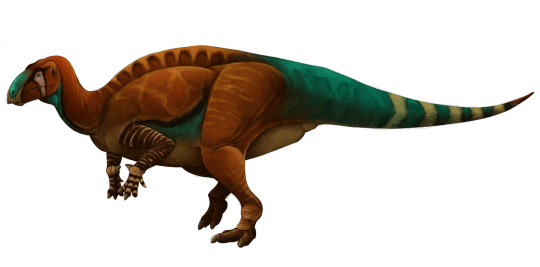
By Scott Reid
Ecosystem: Jinzhousaurus lived in the Yixian Formation, a highly diverse ecosystem showcasing the variety and evolution of birdie dinosaurs at the beginning of the Cretaceous period. This was a diverse coniferous forest in a temperate, seasonal climate. Very humid, it’s likely that Jinzhousaurus would have seen snow on a regular basis. There were notable dry seasons as well, leading to more tough vegetation for Jinzhousaurus to chew on. There were many flowering plants there too, along with ferns, horsetails, ginkgoes, cycads, seed ferns, and so many others - all good food for Jinzhousaurus. This was also a dense freshwater lake environment, with abundant minerals due to volcanic eruptions - leading to periodic environmental turnover.
Jinzhousaurus lived alongside many other kinds of dinosaurs, as this was an exceptionally diverse community. Here there was the ankylosaurid Liaoningosaurus, another ornithopod called Bolong, and an unnamed titanosaur in terms of other herbivores. There were many kinds of small fluffy dinosaurs - the Compsognathid Sinosauropteryx; the raptors Zhenyuanlong, Changyuraptor, Sinornithosaurus, and Tianyuraptor; the Troodontid Jianianhualong; the protobirds Jeholornis, Confuciusornis, and Zhongornis; the Anchiornithid Yixianosaurus; the Opposite Birds Dalingheornis and Shanweiniao; and the early nearly-true-birds Archaeorhynchus, Eogranivora, Yanornis, Hongshanornis, and Longicrusavis. Non-dinosaurs were of course also present - many types of fish, amphibians, and lizards; mammals such as Akidolestes, Sinobaatar, Sinodelphys, Chaoyangodens, and the famous Eomaia; Choristoderes like Hyphalosaurus and Monjurosuchus; and pterosaurs like Cathayopterus and Ningchengopterus. Essentially, a beautiful snapshot of the Early Cretaceous.
Other: Jinzhousaurus is sort of a mix between earlier ornithopods and the later hadrosaurs, so its classification was difficult to place for a while. But now it seems to be a basal member of the group that lead to the Hadrosaurids, rather than more close to Iguanodon proper.
~ By Meig Dickson
Sources under the Cut
Amiot, R., X. Wang, Z. Zhou, X. X. Wang, E. Buffetaut, C. Lécuyer, Z. Ding, F. Fluteau, T. Hibino, N. Kusuhashi, J. Mo, V. Suteethorn, Y. Y. Wang, X. Xu, F. Zhang. 2011. Oxygen isotopes of East Asian dinosaurs reveal exceptionally cold Early Cretaceous climates. Proceedings of the National Academy of Sciences 108 (13): 5179 - 5183.
Barrett, P. M., R. J. Butler, W. Xiao-Lin, X. Xing. 2009. Cranial anatomy of the Iguanodontoid Ornithopod Jinzhousaurus yangi from the Lower Cretaceous Yixian Formation of China. Acta Paleontologica Polonica 54(1): 35-48.
McDonald, A. T., D. G. Wolfe, J. I. Kirkland. 2010. A new basal hadrosauroid (Dinosauria: Ornithopoda) from the Turonian of New Mexico. Journal of Vertebrate Paleontology 30(3): 799-812.
Meng, F.X.; Gao, S.; Liu, X.M. (2008). "U-Pb zircon geochronology and geochemistry of volcanic rocks of the Yixian Formation in the Lingyuan area, western Liaoning, China". Geological Bulletin of China. 27: 364–373.
Wang, X., & X. Xu. 2001. A new iguanodontid (Jinzhousaurus yangi gen. et sp. nov.) from the Yixian Formation of western Liaoning, China. Chinese Science Bulletin 46(19): 1669-1672.
Wang, Y., S. Zheng, X. Yang, W. Zhang, Q. Ni. 2006. The biodiversity and palaeoclimate of confier floras from the Early Cretaceous deposits in western Liaoning, northeast China. International Symposium on Cretaceous Major Geological Events and Earth System: 56A.
Zhou, Z. 2006. Evolutionary radiation of the Jehol Biota: chronological and ecological perspectives. Geological Journal 41: 377-393.
#Jinzhousaurus#Jinzhousaurus yangi#Dinosaur#Ornithopod#Hadrosauroid#Palaeoblr#Cretaceous#Jehol Biota#Eurasia#Herbivore#Terrestrial Tuesday#Factfile#paleontology#prehistory#prehistoric life#dinosaurs#biology#a dinosaur a day#a-dinosaur-a-day#dinosaur of the day#dinosaur-of-the-day#science#nature
109 notes
·
View notes
Photo

In case you hadn't heard quite yet.
Changyuraptor yangi
643 notes
·
View notes
Text
VIDEO: Largest 'Four-Winged' Dinosaur To Date Unearthed In China
VIDEO: Largest ‘Four-Winged’ Dinosaur To Date Unearthed In China
Scientists have discovered what they say is the largest-known feathered dinosaur, and its fossil could provide new insight into prehistoric flight.
(more…)
View On WordPress
#Changyuraptor yangi#Changyuraptor yangi feathers#Changyuraptor yangi fossil#feathered dinosaur#four winged dinosaur#four winged dinosaur china#largest feathered dinosaur#newsy#science news
0 notes
Text
Динозавър с пера е летял преди птиците
Динозавър с пера е летял преди птиците
Непознат вид динозавър, открит в Китай, покрит изцяло с пера и с дълга опашка, подкрепя теорията, че е имало летящи животни още преди да се появят птиците, съобщи АФП.
Динозавърът Changyuraptor yangi е живял преди 125 милиона години. Той е от групата на микрорапторите – малки динозаври с лапи и перната опашка, заради която приличат на големи зъбати кокошки. Въпреки наличието на пера и…
View On WordPress
0 notes
Text
Bizarre Dinosaur Had 4 'Wings,' Long Tail Feathers
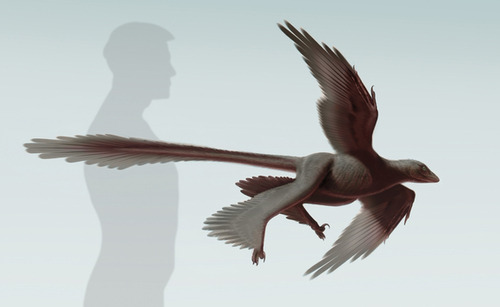
The largest "four-winged" dinosaur known has been found, and this predator has the longest feathers yet outside of birds, researchers say. This new finding yields insights on how dinosaurs may have flown.
Read more on Live Science.
9 notes
·
View notes